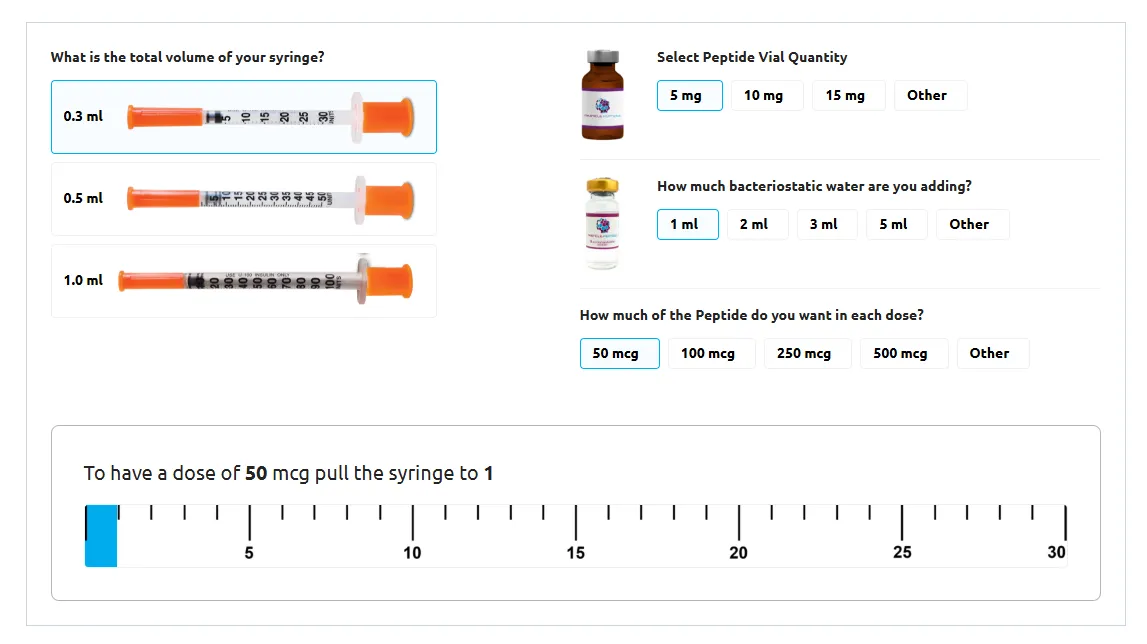What is Peptide Calculator
A peptide calculator is an online tool used by scientists, researchers, and enthusiasts to quickly determine various physiochemical properties of a peptide based on its amino acid sequence.
Instead of performing complex manual calculations, a peptide calculator provides precise results instantly.
Learning Resources
Beginner's Guides & Educational Centers
Video Tutorials (YouTube)
Why You Need a Peptide Calculator
You need a peptide calculator to quickly and accurately determine the physiochemical properties of a peptide. Manually calculating these values for even a short peptide can be tedious and prone to errors. The calculator instantly provides essential information such as:
- Molecular Weight: Crucial for accurately measuring peptides for experiments or dosages.
- Isoelectric Point (pI): Necessary for designing purification strategies, like ion-exchange chromatography.
- Net Charge: Helps predict a peptide's behavior and solubility at different pH levels.
- Hydrophobicity: Offers insight into how the peptide might fold, interact with cell membranes, or dissolve in different solvents.
Who Needs a Peptide Calculator
A peptide calculator is used by a variety of professionals and students in the scientific community. The primary users include:
- Researchers and Scientists: They use the tool to design and analyze peptides for experiments, drug development, and material science.
- Biochemists: They rely on the calculator to understand the properties of naturally occurring peptides and to design new ones for specific functions.
- Pharmaceutical Professionals: They use it during the development of peptide-based drugs to determine key properties that affect stability, delivery, and efficacy.
- Students and Educators: The calculator is an excellent educational tool for learning about peptide chemistry without getting bogged down in manual arithmetic.
- Peptide Enthusiasts and Biohackers: These users often need to reconstitute peptides for personal use and rely on the calculator to get accurate dosing information.
What is the Formula for a Peptide Calculator?
A peptide calculator isn't based on a single formula but rather a set of fundamental equations and principles from biochemistry.
How to Use Our Peptide Calculator
- Input and Output: Explain what information the user needs to input (amino acid sequence) and what the calculator will provide (molecular weight, isoelectric point, etc.).
- Interpreting the Results: Help users understand what the calculated values mean. For example, why is molecular weight important for synthesis, or what does the isoelectric point tell us about a peptide's charge?
- Examples: Include a few clear examples using different peptide sequences to demonstrate the calculator's functionality. This makes the process much less intimidating for beginners.
The A-to-Z of Amino Acids
A reference page or glossary of the 20 common amino acids is a must-have resource.
- Amino Acid Profiles: Create a simple table or list for each amino acid, including its full name, three-letter code, and one-letter code.
- Chemical Properties: Briefly describe each amino acid's properties (e.g., hydrophobic, hydrophilic, charged), which can help users better understand their peptide calculator results.
- Interactive Element: Maybe we can even add a small interactive element where users can click on an amino acid to see its structure.
Key Functions of a Peptide Calculator
- Molecular Weight: This is the total mass of the peptide. The calculator sums the molecular weights of each amino acid residue and the terminal groups (N- and C-termini) to give a precise value.
- Isoelectric Point (pI): The pI is the specific pH at which a peptide has no net electrical charge. The calculator uses the pKa values of the ionizable groups in the peptide to approximate this value. This is crucial for purification processes.
- Net Charge: This feature determines the overall charge of the peptide at a given pH. It's vital for understanding how a peptide will behave in different solution environments.
- Hydrophobicity (GRAVY): The calculator can determine the Grand Average of Hydropathicity (GRAVY), which indicates the peptide's overall hydrophobicity. A positive score suggests a hydrophobic peptide, while a negative score indicates a hydrophilic one. This helps predict how a peptide will interact with water and other molecules.
- Reconstitution and Dosage: For individuals using peptides, a different type of calculator can determine the correct dosage. By entering the amount of peptide in a vial, the volume of reconstitution fluid, and the desired dose, the calculator tells you how much liquid to draw into a syringe.
What Information Do You Need to Input for Accurate Results?
To get accurate results from our peptide calculator, you'll primarily need one crucial piece of information: the amino acid sequence of your peptide.
The calculator uses the sequence as the foundation for all its calculations. You can typically enter this in either a one-letter or three-letter code format, which makes it fast and convenient.
For example, a common peptide might be entered as:
- One-letter code: AWLNR
- Three-letter code: Ala-Trp-Leu-Asn-Arg
From this sequence alone, the calculator can determine fundamental properties like molecular weight, isoelectric point (pI), and hydrophobicity.
Optional Inputs for Specific Calculations
For more detailed analysis, some calculators may allow you to enter additional information:
- pH: If you want to calculate the peptide's net charge at a specific pH, you will need to input that value. This is particularly useful for predicting how a peptide will behave in a certain solution.
- Terminal Modifications: If your peptide has been modified (e.g., acetylated on the N-terminus or amidated on the C-terminus), you can often specify these modifications. This ensures a more precise calculation of the molecular weight.
